|
https://haliimailedistilling.com/
Hawaii Distributor: Youngs Market Company of Hawaii Las Vegas Distributor: Breakthrough Beverages |
Tasting Room Location: 883 Hali'imaile Rd, Makawao, HI 96768 Store Hours/ Tasting Hours Open Everyday 10:00a to 04:00p closed on all major holidays (808) 633-3609 |
Brand Approach
-
Founding Story
-
Hawaii's Influence
<
>
Founding Story
LeVecke Corporation was founded in 1949 by William and Reed LeVecke, Father & Son, in Los Angeles, CA. In the early years, the company was focused solely on Southern California regional distribution of beer and wine. Over the years, the company became focused on the manufacturing of distilled spirits for the largest retailers in the US. The company has been family owned and led since its inception. After having focused a considerable amount of business in the Hawaiian Islands; in 2006, Tim & Neil LeVecke from the 3rd generation of family leadership, decided to actually create their own distillery on the island of Maui.
The LeVecke family has been in the alcohol and spirits business for a long time, but they never distilled anything from scratch. In California, LeVecke Corporation is known as a rectifier in the distilled spirits industry. Rectifiers buy bulk high proof distilled spirits from throughout the world, then blend and bottle them in house. The LeVecke’s have relationships with scotch distilleries in Scotland, Irish whiskey distilleries in Ireland, cognac distilleries in France and so on. LeVecke Corporation can produce anything from small batch vodka to high volume worldwide brands. Many of them, you may know.
Tim & Neil had a dream to make a genuine spirit in Hawaii. Meanwhile, my dad, Mark, actually had a distillery in Colorado where he and I were making one of the only vodkas in the world out of glass stills. Our distillery got a lot of press and recognition due to our process and purity level of vodka that we were creating at the time. The LeVecke’s saw that, came out and looked at our facility and everything that we were doing out there, really fell in love with the product. We meshed really well -- we were a family business, they're a family business – Tim & Neil were like, "Can we make a product out of anything that grows in Hawaii?"
Naturally, taro and pineapple were the two things that we wanted to start out with. We made a vodka out of both. We used fresh pineapple juice that was flown overnight to us in Colorado and we just filled the batch. We also did the same thing with taro and then we started to do blind taste tests around our local bars [in Colorado]. It tasted better than all the major brands including the one that we were currently making. We were like, "Okay. Now, we've got something. We actually made a better product than what we had." It was the pineapple juice that did it.
Once we figured out that we had a good product, my dad and I moved out to Maui, 2007 and started out in the old Maui Land & Pineapple cannery in Kahului. It took us till about the later part of 2008 to get our license.
When Maui Land & Pineapple closed in 2009 former managers moved upcountry to reopen Haliimaile Pineapple company. When this occurred, the distillery moved with them into their current production space. Then in 2015 the tasting room opened.
LeVecke Corporation was founded in 1949 by William and Reed LeVecke, Father & Son, in Los Angeles, CA. In the early years, the company was focused solely on Southern California regional distribution of beer and wine. Over the years, the company became focused on the manufacturing of distilled spirits for the largest retailers in the US. The company has been family owned and led since its inception. After having focused a considerable amount of business in the Hawaiian Islands; in 2006, Tim & Neil LeVecke from the 3rd generation of family leadership, decided to actually create their own distillery on the island of Maui.
The LeVecke family has been in the alcohol and spirits business for a long time, but they never distilled anything from scratch. In California, LeVecke Corporation is known as a rectifier in the distilled spirits industry. Rectifiers buy bulk high proof distilled spirits from throughout the world, then blend and bottle them in house. The LeVecke’s have relationships with scotch distilleries in Scotland, Irish whiskey distilleries in Ireland, cognac distilleries in France and so on. LeVecke Corporation can produce anything from small batch vodka to high volume worldwide brands. Many of them, you may know.
Tim & Neil had a dream to make a genuine spirit in Hawaii. Meanwhile, my dad, Mark, actually had a distillery in Colorado where he and I were making one of the only vodkas in the world out of glass stills. Our distillery got a lot of press and recognition due to our process and purity level of vodka that we were creating at the time. The LeVecke’s saw that, came out and looked at our facility and everything that we were doing out there, really fell in love with the product. We meshed really well -- we were a family business, they're a family business – Tim & Neil were like, "Can we make a product out of anything that grows in Hawaii?"
Naturally, taro and pineapple were the two things that we wanted to start out with. We made a vodka out of both. We used fresh pineapple juice that was flown overnight to us in Colorado and we just filled the batch. We also did the same thing with taro and then we started to do blind taste tests around our local bars [in Colorado]. It tasted better than all the major brands including the one that we were currently making. We were like, "Okay. Now, we've got something. We actually made a better product than what we had." It was the pineapple juice that did it.
Once we figured out that we had a good product, my dad and I moved out to Maui, 2007 and started out in the old Maui Land & Pineapple cannery in Kahului. It took us till about the later part of 2008 to get our license.
When Maui Land & Pineapple closed in 2009 former managers moved upcountry to reopen Haliimaile Pineapple company. When this occurred, the distillery moved with them into their current production space. Then in 2015 the tasting room opened.
When creating the distillery, the Nigburs also wanted to integrate into the community instead of being “a company that moved here from the mainland to just do mainland things.” Nigbur’s further explained, “We really wanted to embrace the culture and come in and do something that, not only we and the LeVecke’s would be proud of, but that people that were born and raised here and knew the Hawaiian culture would also look and go, "Yes, these guys are doing it right, they're paying attention, they're doing the right things." We did not want to just come in and slap a mainland feel on a local product. I mean my whole family moved out here. My wife's out here, my dad, my mom, my sisters, we came all in 2007 and we wanted to embrace the culture as much as possible, as much as everyone embraced us.”
Part of the way the Nigbur’s embraced the culture was to learn about the history of Haliimaile and other places. Nigbur said, “We're in a lot of historical places. Haliimaile has a lot of history with the pineapple farm and the General Store. Everything here was for the farm and for pineapple workers…it was all in this neighborhood. They had their own currency. It was just kind of wild to be producing a product within so much history surrounding us as well. We try to put that out for everybody else with the product. [Also], With Fid Street, not only are you getting a gin, but if you look into what Fid Street actually is, you'll get a little bit of a history lesson at the same time.
The company also integrated into the community by hosting and sponsoring community events. They do a benefit for the Cancer Institute in October, where pink labels adorn their bottles and proceeds are donated. Nigbur noted, “I’m a cancer survivor myself, so for me, personally, it hits home. Then for the LeVecke’s and our company to do that, and then like I said, helping with beach cleanups and any fundraiser where we can help out our local community, we really try to jump on board with that.”
Part of the way the Nigbur’s embraced the culture was to learn about the history of Haliimaile and other places. Nigbur said, “We're in a lot of historical places. Haliimaile has a lot of history with the pineapple farm and the General Store. Everything here was for the farm and for pineapple workers…it was all in this neighborhood. They had their own currency. It was just kind of wild to be producing a product within so much history surrounding us as well. We try to put that out for everybody else with the product. [Also], With Fid Street, not only are you getting a gin, but if you look into what Fid Street actually is, you'll get a little bit of a history lesson at the same time.
The company also integrated into the community by hosting and sponsoring community events. They do a benefit for the Cancer Institute in October, where pink labels adorn their bottles and proceeds are donated. Nigbur noted, “I’m a cancer survivor myself, so for me, personally, it hits home. Then for the LeVecke’s and our company to do that, and then like I said, helping with beach cleanups and any fundraiser where we can help out our local community, we really try to jump on board with that.”
-
MAUI GOLD® PINEAPPLE
-
Water
-
Yeast
<
>
According to Nigbur, “Pineapple [in general] is a good fruit for making spirits because it picks up enzymes and [elements] from the natural atmosphere, and ferment on its own. If you've ever cut a pineapple in half after it's been ripened on the counter for a while and you see bubbles coming up through it, that's alcohol being created within the fruit itself.”
Maui Gold®’s low-acid, high sugar pineapples in particular are crucial for Haliimaile’s distilling operation. Nigbur noted, “Maui Gold® is, in my opinion, a superior pineapple that's just perfect for making the spirits that we make. When it comes to fermentation, the more acid that you have within the juice, the harder it is for the yeast to do its thing [because] it has to fight against that acid.”
The acquisition of Haliimaile pineapple has proven to be helpful to the Distillery. Nigbur recanted, “Before, [The acquisition of Maui Gold] we had to plan our production around their farming schedule. Now, we're able to work together to let them know exactly what we need and what their capabilities are. It keeps a steady flow of production year-round and gives them a better schedule too, because they know how much they have to produce with that guarantee with us, the winery and Maui Brew Co.
Now, we can go into the fields and we know what fruit is what and exactly what we're getting. We work with the botanists over there, so we know we need this kind of sugar content with everything. It really helps keep the quality and consistency of our product year-round.
Every now and then we'll go out there with-- Mike Ross is one of the guys who judge the quality of the fruit at the Pineapple Company. We'll walk out there with him and we'll just pick a fruit right off, cut it up in the field and check it out, taste it, and see exactly what we're working with and just go from there.”
[Pineapple is] not as perishable as sugarcane juice or other juices where it has to be, like once you juice it, you got a matter of an hour or so to work with it, so. By the time it gets back to us, we'll just pitch a little bit of sugar or a little bit of water and juice, and then we'll put our yeast in there and that's it. Let it do its thing. Yes, it's got a real high sugar content, so we have to cut it back with a little bit of water, otherwise it will ferment too much and overtake the yeast and the yeast won't be able to do its thing, it kind of burns out too fast. We just cut the fresh juice with a little bit of water and yeast. That's it.”
Maui Gold®’s low-acid, high sugar pineapples in particular are crucial for Haliimaile’s distilling operation. Nigbur noted, “Maui Gold® is, in my opinion, a superior pineapple that's just perfect for making the spirits that we make. When it comes to fermentation, the more acid that you have within the juice, the harder it is for the yeast to do its thing [because] it has to fight against that acid.”
The acquisition of Haliimaile pineapple has proven to be helpful to the Distillery. Nigbur recanted, “Before, [The acquisition of Maui Gold] we had to plan our production around their farming schedule. Now, we're able to work together to let them know exactly what we need and what their capabilities are. It keeps a steady flow of production year-round and gives them a better schedule too, because they know how much they have to produce with that guarantee with us, the winery and Maui Brew Co.
Now, we can go into the fields and we know what fruit is what and exactly what we're getting. We work with the botanists over there, so we know we need this kind of sugar content with everything. It really helps keep the quality and consistency of our product year-round.
Every now and then we'll go out there with-- Mike Ross is one of the guys who judge the quality of the fruit at the Pineapple Company. We'll walk out there with him and we'll just pick a fruit right off, cut it up in the field and check it out, taste it, and see exactly what we're working with and just go from there.”
[Pineapple is] not as perishable as sugarcane juice or other juices where it has to be, like once you juice it, you got a matter of an hour or so to work with it, so. By the time it gets back to us, we'll just pitch a little bit of sugar or a little bit of water and juice, and then we'll put our yeast in there and that's it. Let it do its thing. Yes, it's got a real high sugar content, so we have to cut it back with a little bit of water, otherwise it will ferment too much and overtake the yeast and the yeast won't be able to do its thing, it kind of burns out too fast. We just cut the fresh juice with a little bit of water and yeast. That's it.”
Reverse osmosis is used in multiple steps throughout the distillation process.
The water treatment process starts with Upcountry Maui Water which is then treated with reverse osmosis. According to Nigbur, “With the taste tests that we've done, the vodka tastes the best and you get the most of that pineapple flavor when using reverse osmosis or distilled water. [However], distilled water costs more to produce and it doesn't change the product. Reverse osmosis is more efficient and more cost-effective, and it works better in my opinion.”
The water treatment process starts with Upcountry Maui Water which is then treated with reverse osmosis. According to Nigbur, “With the taste tests that we've done, the vodka tastes the best and you get the most of that pineapple flavor when using reverse osmosis or distilled water. [However], distilled water costs more to produce and it doesn't change the product. Reverse osmosis is more efficient and more cost-effective, and it works better in my opinion.”
Nigbur’s Father Mark, the former Master Distiller for Hali’imiale Distilling Co., worked with a Texas Laboratory to develop a proprietary yeast strain specifically to ferment pineapple. The development process entailed providing the yeast producer pineapple, which was then tested for microbes, sugar content, and other biological factors. The utilization of this yeast strain is particularly important because pineapple enzymes can be difficult to work with. This yeast strain is also used to produce Mahina rum. According to Nigbur, “The yeast works with the sugar. Not all yeast will work with the pineapple, but all yeast that works with pineapple will definitely work with sugar.”
Distillation
-
The Stills
-
Distilling Approach
<
>
Stripping Still
The stainless steel stripping still, designed by Mark Nigbur, is used in two ways. It is used like a pot still in the production of Mahina rum, and it is used to separate the alcohol from the non-alcoholic components of the pineapple distillate.
Glass Stills
The Nigburs believe glass stills produces a more pure product as there are some impurities imparted by copper and stainless steel. The glass still was custom designed by Mark Nigbur in collaboration with the still manufacturer, and is similar to pharmaceutical stills. The stills combined different technologies from different distillation methods and utilized as much glass as possible.
The still is comprised of two parts. The base is a German-made, borosilicate glass ball that can tolerate extreme temperature fluctuations without cracking. The remainder of the still’s body is hand-blown glass and manufactured in Colorado. Nigbur explained, “We found a guy [in Colorado] when our original distillery was there. The whole thing is [created] by hand and they're very unique and one of a kind.” Each still can only produce 12 to 24 gallons of pure pineapple distillate per run. This means that increased production output would require procurement of additional glass stills. Copper is still utilized as Nigbur noted, “There is a giant copper rod that vodka passes through on its way to the glass vessel that we store it in. The little bit of copper and stainless [steel] is involved because you have to have some copper to remove sulfites and certain compounds.”
The stainless steel stripping still, designed by Mark Nigbur, is used in two ways. It is used like a pot still in the production of Mahina rum, and it is used to separate the alcohol from the non-alcoholic components of the pineapple distillate.
Glass Stills
The Nigburs believe glass stills produces a more pure product as there are some impurities imparted by copper and stainless steel. The glass still was custom designed by Mark Nigbur in collaboration with the still manufacturer, and is similar to pharmaceutical stills. The stills combined different technologies from different distillation methods and utilized as much glass as possible.
The still is comprised of two parts. The base is a German-made, borosilicate glass ball that can tolerate extreme temperature fluctuations without cracking. The remainder of the still’s body is hand-blown glass and manufactured in Colorado. Nigbur explained, “We found a guy [in Colorado] when our original distillery was there. The whole thing is [created] by hand and they're very unique and one of a kind.” Each still can only produce 12 to 24 gallons of pure pineapple distillate per run. This means that increased production output would require procurement of additional glass stills. Copper is still utilized as Nigbur noted, “There is a giant copper rod that vodka passes through on its way to the glass vessel that we store it in. The little bit of copper and stainless [steel] is involved because you have to have some copper to remove sulfites and certain compounds.”
Approach to Distilling
Glass stills are implemented to produce the most pure product possible. Nigbur provided the following insight: “We strive for purity in all of our products. That's why we use our glass distillation. That's probably the number one thing that the LeVecke family, my dad, and I had in Colorado and wanted to transfer to Maui. I think we've done that. [However] instead of [making] a vodka that's almost too odorless and tasteless, we wanted [patrons] to taste a little bit of that pineapple on the back end to differentiate it from grain vodkas and potato vodkas.”
The distillery also takes pride in their handcrafted approach. Nigbur said, “The only hitch [with glass distillation] is the amount that you can distill, but we've always been a company that wants to do quality over quantity. We still want to maintain that handcrafted feel and we've done that from mash to bottling. We stir all our mash by hand. All of our stills are loaded [and operated] by hand. It's a mix of old world distilling and modern technology.”
Farm-to-table agriculture is also important to the distillery. This commitment can be seen through the LeVecke family literally buying the farm; LeVecke Corp acquired Haliimaile Pineapple Company in 2018. Nigbur commented, “We always try for that farm-table mentality of having something that was grown here, produced here, distilled, and bottled here.”
Glass stills are implemented to produce the most pure product possible. Nigbur provided the following insight: “We strive for purity in all of our products. That's why we use our glass distillation. That's probably the number one thing that the LeVecke family, my dad, and I had in Colorado and wanted to transfer to Maui. I think we've done that. [However] instead of [making] a vodka that's almost too odorless and tasteless, we wanted [patrons] to taste a little bit of that pineapple on the back end to differentiate it from grain vodkas and potato vodkas.”
The distillery also takes pride in their handcrafted approach. Nigbur said, “The only hitch [with glass distillation] is the amount that you can distill, but we've always been a company that wants to do quality over quantity. We still want to maintain that handcrafted feel and we've done that from mash to bottling. We stir all our mash by hand. All of our stills are loaded [and operated] by hand. It's a mix of old world distilling and modern technology.”
Farm-to-table agriculture is also important to the distillery. This commitment can be seen through the LeVecke family literally buying the farm; LeVecke Corp acquired Haliimaile Pineapple Company in 2018. Nigbur commented, “We always try for that farm-table mentality of having something that was grown here, produced here, distilled, and bottled here.”
The Product
-
PAU VODKA
-
Inspiration
-
Ingredients
-
Process
<
>
Product Name
PAU’s name stems from LeVecke’s multi-year nationwide search for a distiller to make product in Hawaii. According to Nigbur, ““The LeVecke’s and my father couldn't find anything that worked to produce a product that they were happy with. They tried distilling other Hawaiian materials like taro root, but nothing offered the quality they were striving for. When they tried distilling pineapple and realized the quality, it was like, “We did it. We're done.”” The word PAU means finished, done, there is no more.” When it came time to naming the vodka, due to the company’s belief that it can’t get any better, Nigbur said it references PAU to say this is it. You found it. You're done. Drink it. That's all you got to worry about. You don't have to look for another vodka. You found it.”
PAU’s name stems from LeVecke’s multi-year nationwide search for a distiller to make product in Hawaii. According to Nigbur, ““The LeVecke’s and my father couldn't find anything that worked to produce a product that they were happy with. They tried distilling other Hawaiian materials like taro root, but nothing offered the quality they were striving for. When they tried distilling pineapple and realized the quality, it was like, “We did it. We're done.”” The word PAU means finished, done, there is no more.” When it came time to naming the vodka, due to the company’s belief that it can’t get any better, Nigbur said it references PAU to say this is it. You found it. You're done. Drink it. That's all you got to worry about. You don't have to look for another vodka. You found it.”
Process
PAU takes 10 days from pineapple picking to bottling. Juicing takes approximately a day. Then fermentation takes between four and seven days, depending on the weather. Distillation takes approximately a day. Then blending and bottling takes another day.
Juicing
The Maui Gold® pineapple is picked in Haliimaile and is trucked to Maui Wine for juicing in their bladder press.
Fermentation
Tanks used for fermentation are not temperature regulated because of Haliimaile’s consistent, temperate climate. Nigbur noted, “Being in Makawao and Haliimaile, we're very fortunate that we don't have temperature fluxes like some of the other pockets on the island, so our mash is pretty consistent year-round. It's right around 85-90 degrees. [When] you start to get to 95-100 degrees, the yeast starts to die off. If you get below into the 70s, then the yeast goes dormant. In Colorado, during the winter, we had to heat jacket our mash tanks because the yeast would just go dormant. We are very lucky being in Haliimaile because the temperatures are absolutely optimal for what we do.” To check if the mash is completely fermented, the distillers measure its specific gravity.
Haliimaile’s fermentation process differs from other distilleries’ as many have a mash with an alcohol by volume in the single-digits. For example, some whiskey distilleries ferment to as low as 4% or 5%. Haliimaile Distillery; however, gets up to 15% depending on the temperature.
Distillation
Distillation starts with stripping alcohol out of the mash in a stainless steel stripper still. Then it’s purified in the glass stills to 96% alcohol.
The distillation process is similar to that of using a pot still. That is, it requires the distiller to know when to make cuts to the heads, hearts, and tails. Nigbur noted, “Within distillation, you have different compounds and different alcohols that evaporate at different temperatures and different rates. It's up to me, as a distiller, to know what those taste like, to know when they're coming off, and to make sure they're not getting into the ethanol that we take. It's all a matter of temperature control, smell and taste. When you're drinking whiskey and rum, you get some heads and tails. That's what gives [rum and whiskey] that flavor profile. You [also] have a lot more sugars and [flavor compounds] within those alcohols.”
Filtering and Bottling
A carbon plate system is used for light filtration. Then, a 0.5 micron membrane filter, which can be used to filter blood plasma, is utilized to ensure that there are no particulates in the spirit.
When asked if any additional ingredients like sugar or glycol are added, Nigbur responded, “No. It's just ethanol and water.”
PAU takes 10 days from pineapple picking to bottling. Juicing takes approximately a day. Then fermentation takes between four and seven days, depending on the weather. Distillation takes approximately a day. Then blending and bottling takes another day.
Juicing
The Maui Gold® pineapple is picked in Haliimaile and is trucked to Maui Wine for juicing in their bladder press.
Fermentation
Tanks used for fermentation are not temperature regulated because of Haliimaile’s consistent, temperate climate. Nigbur noted, “Being in Makawao and Haliimaile, we're very fortunate that we don't have temperature fluxes like some of the other pockets on the island, so our mash is pretty consistent year-round. It's right around 85-90 degrees. [When] you start to get to 95-100 degrees, the yeast starts to die off. If you get below into the 70s, then the yeast goes dormant. In Colorado, during the winter, we had to heat jacket our mash tanks because the yeast would just go dormant. We are very lucky being in Haliimaile because the temperatures are absolutely optimal for what we do.” To check if the mash is completely fermented, the distillers measure its specific gravity.
Haliimaile’s fermentation process differs from other distilleries’ as many have a mash with an alcohol by volume in the single-digits. For example, some whiskey distilleries ferment to as low as 4% or 5%. Haliimaile Distillery; however, gets up to 15% depending on the temperature.
Distillation
Distillation starts with stripping alcohol out of the mash in a stainless steel stripper still. Then it’s purified in the glass stills to 96% alcohol.
The distillation process is similar to that of using a pot still. That is, it requires the distiller to know when to make cuts to the heads, hearts, and tails. Nigbur noted, “Within distillation, you have different compounds and different alcohols that evaporate at different temperatures and different rates. It's up to me, as a distiller, to know what those taste like, to know when they're coming off, and to make sure they're not getting into the ethanol that we take. It's all a matter of temperature control, smell and taste. When you're drinking whiskey and rum, you get some heads and tails. That's what gives [rum and whiskey] that flavor profile. You [also] have a lot more sugars and [flavor compounds] within those alcohols.”
Filtering and Bottling
A carbon plate system is used for light filtration. Then, a 0.5 micron membrane filter, which can be used to filter blood plasma, is utilized to ensure that there are no particulates in the spirit.
When asked if any additional ingredients like sugar or glycol are added, Nigbur responded, “No. It's just ethanol and water.”
-
FID STREET GIN
-
Inspiration
-
Ingredients
-
Production
<
>
The LeVecke’s knew that they wanted to expand into new spirit categories at the distillery. Nigbur’s passion for gin stimulated an interest to develop a new brand. Nigbur, along with their lead distiller at the time, developed the liquid. And the LeVecke’s developed the brand. It quickly became a passion project. “I'm a gin drinker. [The gin] came to development from a dissatisfaction with the gins that are available on the market. When [the gin category] started to pick up speed on the mainland and the marketplace as a whole, that's when we decided that it is a good product. We need to come out with that."
Product Name
The name of the gin references modern Hawaiian history. “Back in the old time, when sailors would [get a drink in Honolulu], they called it “drinking a fid.” When they would pull up to Honolulu Port and get off the boat, all the bars were right there [on Nuuanu Avenue], which they called Fid Street.”
Flavor Development
Flavor development was the result of fifty different test batches which referenced recipes ranging from London Dry to American Fusion. Nigbur commented on his approach to flavor development: “I studied all the different ways that gin can be made; there's steam infusion and there's bathtub gin where you soak the botanicals. Knowing there's three ways to extract flavor, smell, and oils from any compound (heat, water, and alcohol); I wanted to utilize all three. If you just use the alcohol, you're only going to get the oils, esters, terpenes and everything [else] that binds with that alcohol. If you only use water, you're only going to get the [flavor compounds] that resonate and bind with the water and heat. But, if you utilize all three, you're getting [every flavor compound] out of whatever material that you're trying to extract from. I didn't want to do vapor because I felt like it only produced a certain amount [of flavor] and I wanted everything. I like drinking old school cocktails, like Negronis, and I found that when certain gin brands are mixed with heavy herbal botanical liqueurs, the flavor of the gin is lost. I wanted a gin that could be drank straight as a Martini, or that could be mixed with some of the most potent mixers and still shine and retain its gin flavor profile.”
Product Name
The name of the gin references modern Hawaiian history. “Back in the old time, when sailors would [get a drink in Honolulu], they called it “drinking a fid.” When they would pull up to Honolulu Port and get off the boat, all the bars were right there [on Nuuanu Avenue], which they called Fid Street.”
Flavor Development
Flavor development was the result of fifty different test batches which referenced recipes ranging from London Dry to American Fusion. Nigbur commented on his approach to flavor development: “I studied all the different ways that gin can be made; there's steam infusion and there's bathtub gin where you soak the botanicals. Knowing there's three ways to extract flavor, smell, and oils from any compound (heat, water, and alcohol); I wanted to utilize all three. If you just use the alcohol, you're only going to get the oils, esters, terpenes and everything [else] that binds with that alcohol. If you only use water, you're only going to get the [flavor compounds] that resonate and bind with the water and heat. But, if you utilize all three, you're getting [every flavor compound] out of whatever material that you're trying to extract from. I didn't want to do vapor because I felt like it only produced a certain amount [of flavor] and I wanted everything. I like drinking old school cocktails, like Negronis, and I found that when certain gin brands are mixed with heavy herbal botanical liqueurs, the flavor of the gin is lost. I wanted a gin that could be drank straight as a Martini, or that could be mixed with some of the most potent mixers and still shine and retain its gin flavor profile.”
Base Spirit
High Proof Pineapple Spirit
Botanicals
Lavender, Orange Rinds, Orris, Lemon Rinds, Fennel, Juniper, Grains of Paradise, Cardamon, Coriander, Cedar Leaf, Angelica
Botanicals are either sourced locally or from a purveyor which sources from all over the world. Ali’i Kula Lavender Farm in Kula, Maui, for example, is the source of the lavender. Nigbur is also attempting to source local juniper. He utilizes organic sources as much as possible, too.
High Proof Pineapple Spirit
Botanicals
Lavender, Orange Rinds, Orris, Lemon Rinds, Fennel, Juniper, Grains of Paradise, Cardamon, Coriander, Cedar Leaf, Angelica
Botanicals are either sourced locally or from a purveyor which sources from all over the world. Ali’i Kula Lavender Farm in Kula, Maui, for example, is the source of the lavender. Nigbur is also attempting to source local juniper. He utilizes organic sources as much as possible, too.
Botanical Infusion and Distillation
Botanicals are infused into the high proof alcohol for 24 hours within the bowl of the glass stills. When the alcohol is then heated for distillation, heat extraction occurs.
Blending and Bottling
The distilled gin is then brought to proof with reverse osmosis water before bottling.
Botanicals are infused into the high proof alcohol for 24 hours within the bowl of the glass stills. When the alcohol is then heated for distillation, heat extraction occurs.
Blending and Bottling
The distilled gin is then brought to proof with reverse osmosis water before bottling.
-
MAHINA RUM
-
Inspiration
-
Ingredients
-
Process
<
>
According to Nigbur, Mahina Rum was developed when they saw how some of the rums were being made. “A lot of them were Agricole style. No one was really utilizing the turbinado sugar and molasses combined. We [also] wanted to enhance [the rum] with flavor profiles like vanilla, kola nut, black pepper, and similar [ingredients] to round off [the rum] and create something unique. It's not spiced rum and it's not a traditional dark rum. It's just kind of like a hybrid of rums.” (Nigbur)
Base Fermentable
Turbanado sugar from the Mainland
The benefit of turbinado sugar is that it has both the sucrose and molasses components of the sugar, unlike molasses which is stripped of sucrose. Also, unlike fresh pressed sugarcane juice which has one hour to get into fermentation, turbinado sugar is shelf stable. From a flavor perspective, Nigbur noted, “Turbanado sugar also gives a nice, rounded out, earthy flavor, but still creates a pretty pure-tasting product without a lot of congeners.”
Flavors
Kona coffee distillate, Madagascar vanilla, cocoa essence, clove, cinnamon, and citrus oils.
Flavors are all-natural extracts developed at a California flavor house.
To develop the flavors, there are multiple techniques. These include: freeze extractions, carbon dioxide extractions, cold distillation extractions, and hot extractions.
Turbanado sugar from the Mainland
The benefit of turbinado sugar is that it has both the sucrose and molasses components of the sugar, unlike molasses which is stripped of sucrose. Also, unlike fresh pressed sugarcane juice which has one hour to get into fermentation, turbinado sugar is shelf stable. From a flavor perspective, Nigbur noted, “Turbanado sugar also gives a nice, rounded out, earthy flavor, but still creates a pretty pure-tasting product without a lot of congeners.”
Flavors
Kona coffee distillate, Madagascar vanilla, cocoa essence, clove, cinnamon, and citrus oils.
Flavors are all-natural extracts developed at a California flavor house.
To develop the flavors, there are multiple techniques. These include: freeze extractions, carbon dioxide extractions, cold distillation extractions, and hot extractions.
Fermentation
The fermentation of turbinado sugar is similar to the fermentation of pineapple. It starts with the same reverse osmosis water and the same yeast that is then combined with sugar in non-temperature controlled fermentation tanks. Similarly, the fermentation time is also four to six days. This results in a mash with 12% alcohol by volume. According to Nigbur, “It is a little lower brix than the pineapple juice.”
Distillation
The mash is distilled only in the stainless steel stripper stills. Nigbur noted, “It's not run through the glass stills because you don't want to distill rum to purity. You want to distill it to about 60-70% in order to maintain that flavor profile. The more pure [and high proof] you [distill to], the less flavor and smell you get from the product. Most whiskeys, tequilas, rum, Scotch, ect. are distilled anywhere from 60-70%.”
Blending, Proofing, Bottling
After coming off the still, natural extracts and sugar are added during the blending and proofing process. After proofing, Mahina Rum is then bottled without aging.
The fermentation of turbinado sugar is similar to the fermentation of pineapple. It starts with the same reverse osmosis water and the same yeast that is then combined with sugar in non-temperature controlled fermentation tanks. Similarly, the fermentation time is also four to six days. This results in a mash with 12% alcohol by volume. According to Nigbur, “It is a little lower brix than the pineapple juice.”
Distillation
The mash is distilled only in the stainless steel stripper stills. Nigbur noted, “It's not run through the glass stills because you don't want to distill rum to purity. You want to distill it to about 60-70% in order to maintain that flavor profile. The more pure [and high proof] you [distill to], the less flavor and smell you get from the product. Most whiskeys, tequilas, rum, Scotch, ect. are distilled anywhere from 60-70%.”
Blending, Proofing, Bottling
After coming off the still, natural extracts and sugar are added during the blending and proofing process. After proofing, Mahina Rum is then bottled without aging.
-
PANIOLO WHISKEY
-
Inspiration
-
Ingredients
-
Process
<
>
The team wanted to develop a whiskey; however, in an effort to be sustainable, they decided against importing the raw materials. Nigbur noted, “It didn't make sense for us to ship in the malted barley, corn, rye, and everything that's necessary to make quality whiskey. There are [already] distilleries on the mainland producing high-quality whiskey with all of those ingredients right in their backyard.”
Product Name
The Paniolo pre-date the American Cowboy by decades. They, however, didn’t receive national acclaim until the 1908 Frontier Day Rodeo in Cheyenne, Wyoming. There, competing amongst some of the best cowboys in the world, Paniolos Ikua Purdy, Archie Ka‘au‘a, and Jack Low finished first, third, and sixth respectively, with Purdy being crowned the champion steer roper of the world. This paniolo culture ran strong through the pasture lands of Hawaii, including those in Haliimaile. Until this day, Paniolo culture permeates Upcountry Maui.
Paniolo Whiskey is an ode to these legendary Paniolo, and is reflected through the blend of pineapple distillate from Hawaii; American whiskey is done to reflect the Paniolo culture that blended European, Hispanic, and Asian influences with Hawaiian roots.
Product Name
The Paniolo pre-date the American Cowboy by decades. They, however, didn’t receive national acclaim until the 1908 Frontier Day Rodeo in Cheyenne, Wyoming. There, competing amongst some of the best cowboys in the world, Paniolos Ikua Purdy, Archie Ka‘au‘a, and Jack Low finished first, third, and sixth respectively, with Purdy being crowned the champion steer roper of the world. This paniolo culture ran strong through the pasture lands of Hawaii, including those in Haliimaile. Until this day, Paniolo culture permeates Upcountry Maui.
Paniolo Whiskey is an ode to these legendary Paniolo, and is reflected through the blend of pineapple distillate from Hawaii; American whiskey is done to reflect the Paniolo culture that blended European, Hispanic, and Asian influences with Hawaiian roots.
Base Whiskey
Instead, three-year-old Kentucky Straight Bourbon is sourced because, according to Nigbur, “[this particular bourbon] is one of the best bourbons you could get in the world, in my opinion.”
Instead, three-year-old Kentucky Straight Bourbon is sourced because, according to Nigbur, “[this particular bourbon] is one of the best bourbons you could get in the world, in my opinion.”
Blending and Aging
The pineapple distillate and Kentucky Straight Bourbon is blended and then aged in-house. The aging process is in constant evolution. Nigbur noted, “We're always tinkering and messing around with different ways to enhance and make Paniolo Whiskey better. [The duration of aging is also] something that is environmentally determined, depending on the time of year and the temperature. We have a window of time that we want to hit, but it's never consistent. You always have to taste [test] because if you're aging a barrel fifteen feet in the air versus at ground level, it's going to age completely different. If [the temperature] is just cold, it's going to age a certain way and if it's just hot, it's going to age a certain way. If you can get that fluctuation from both, you're loving life. That's why [when] you go to the whiskey houses that are in Ireland and Kentucky, they're always shifting the barrels around. But Makawao [is] hot during the day, and cold at night, so it's nice.”
Barrel Sourcing
Ex-Bourbon American oak, medium char barrels. Also, oak wood chips.
When the whiskey program was first developed, the whiskey was shipped in the barrels they were being aged in. Haliimaile Distillery would then empty the barrels, blend the whiskey and pineapple spirit, then put the blended spirit back into the barrels. These days, however, due to the inefficiency of shipping bourbon in barrels, bourbon now arrives in plastic totes. The original barrels that were sent to Hawaii are then reused. Wood chips are also used to impart additional oak flavoring to the whiskey and decrease extraction time since they contain more surface area.
The pineapple distillate and Kentucky Straight Bourbon is blended and then aged in-house. The aging process is in constant evolution. Nigbur noted, “We're always tinkering and messing around with different ways to enhance and make Paniolo Whiskey better. [The duration of aging is also] something that is environmentally determined, depending on the time of year and the temperature. We have a window of time that we want to hit, but it's never consistent. You always have to taste [test] because if you're aging a barrel fifteen feet in the air versus at ground level, it's going to age completely different. If [the temperature] is just cold, it's going to age a certain way and if it's just hot, it's going to age a certain way. If you can get that fluctuation from both, you're loving life. That's why [when] you go to the whiskey houses that are in Ireland and Kentucky, they're always shifting the barrels around. But Makawao [is] hot during the day, and cold at night, so it's nice.”
Barrel Sourcing
Ex-Bourbon American oak, medium char barrels. Also, oak wood chips.
When the whiskey program was first developed, the whiskey was shipped in the barrels they were being aged in. Haliimaile Distillery would then empty the barrels, blend the whiskey and pineapple spirit, then put the blended spirit back into the barrels. These days, however, due to the inefficiency of shipping bourbon in barrels, bourbon now arrives in plastic totes. The original barrels that were sent to Hawaii are then reused. Wood chips are also used to impart additional oak flavoring to the whiskey and decrease extraction time since they contain more surface area.

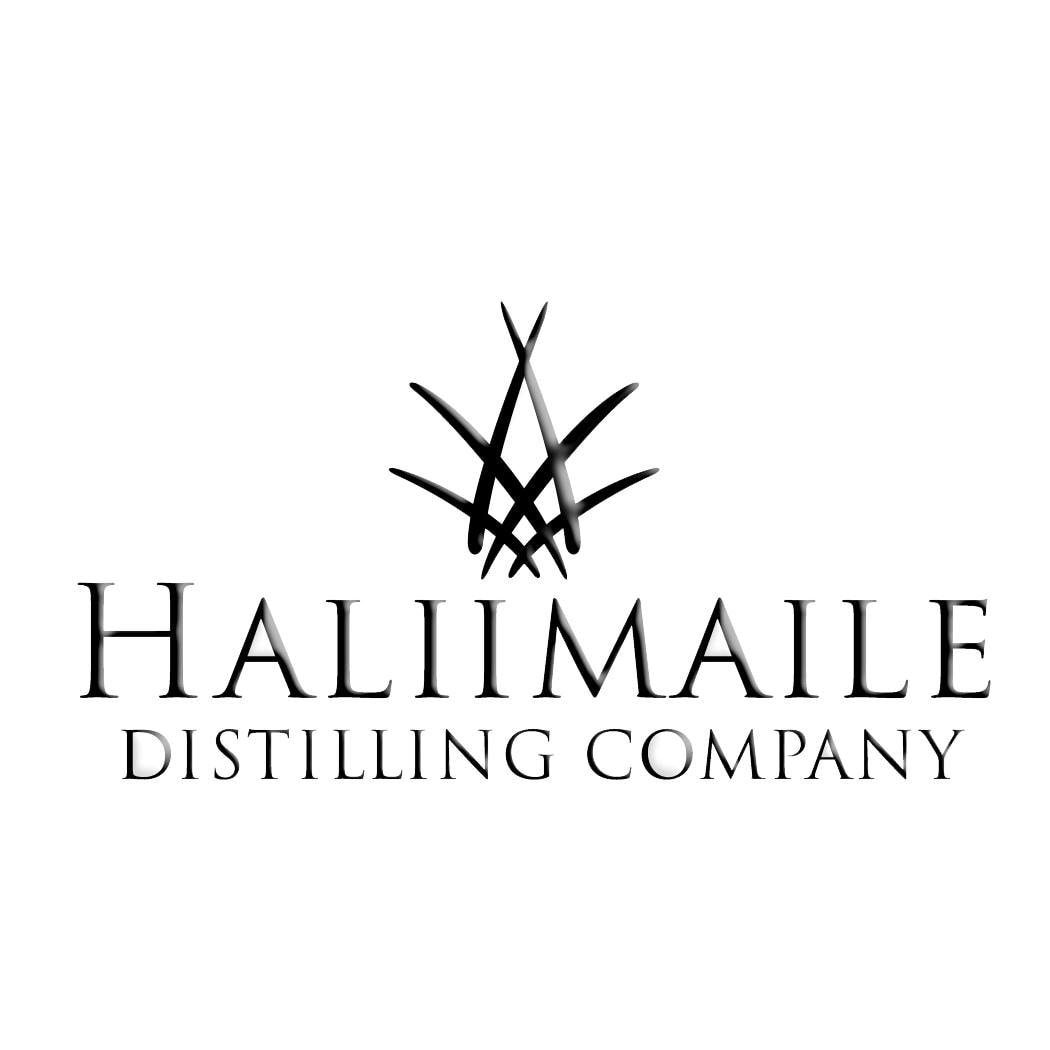
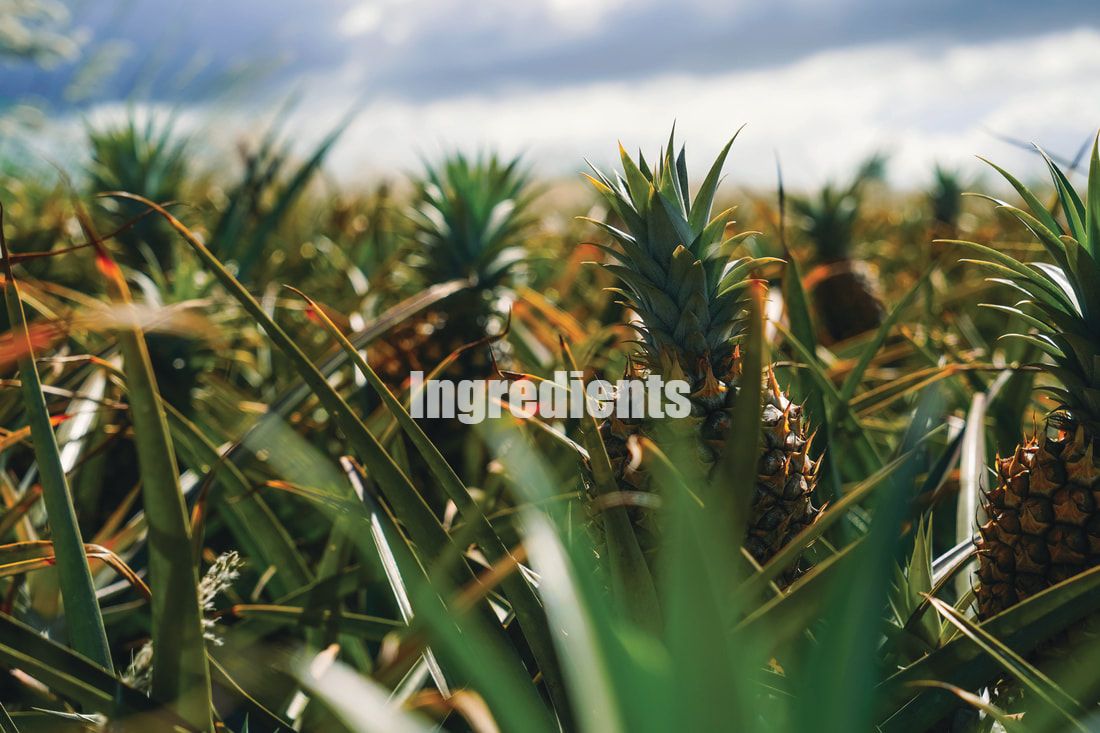
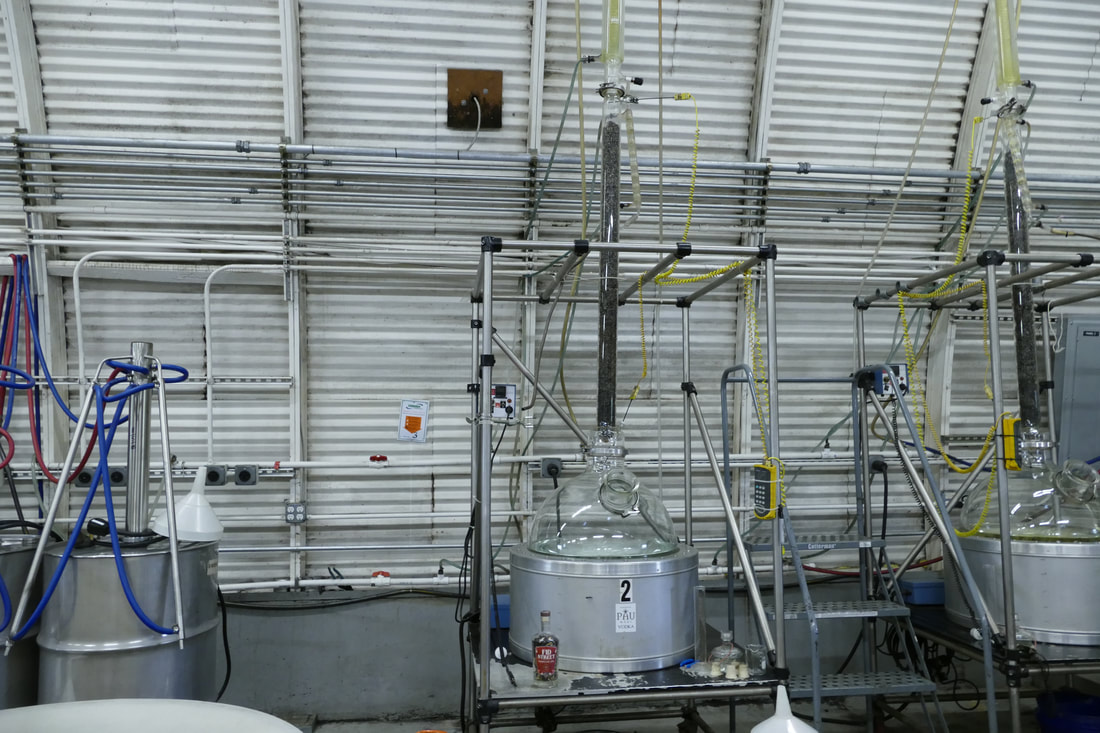
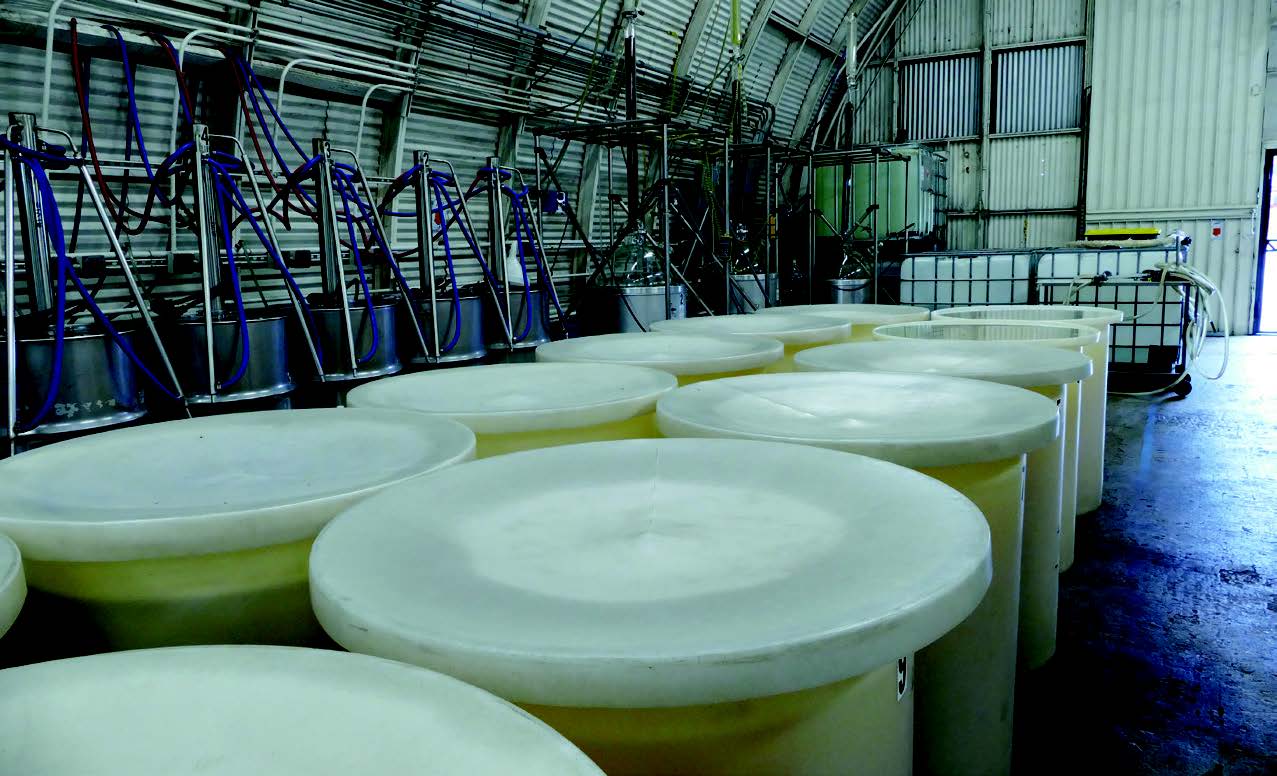
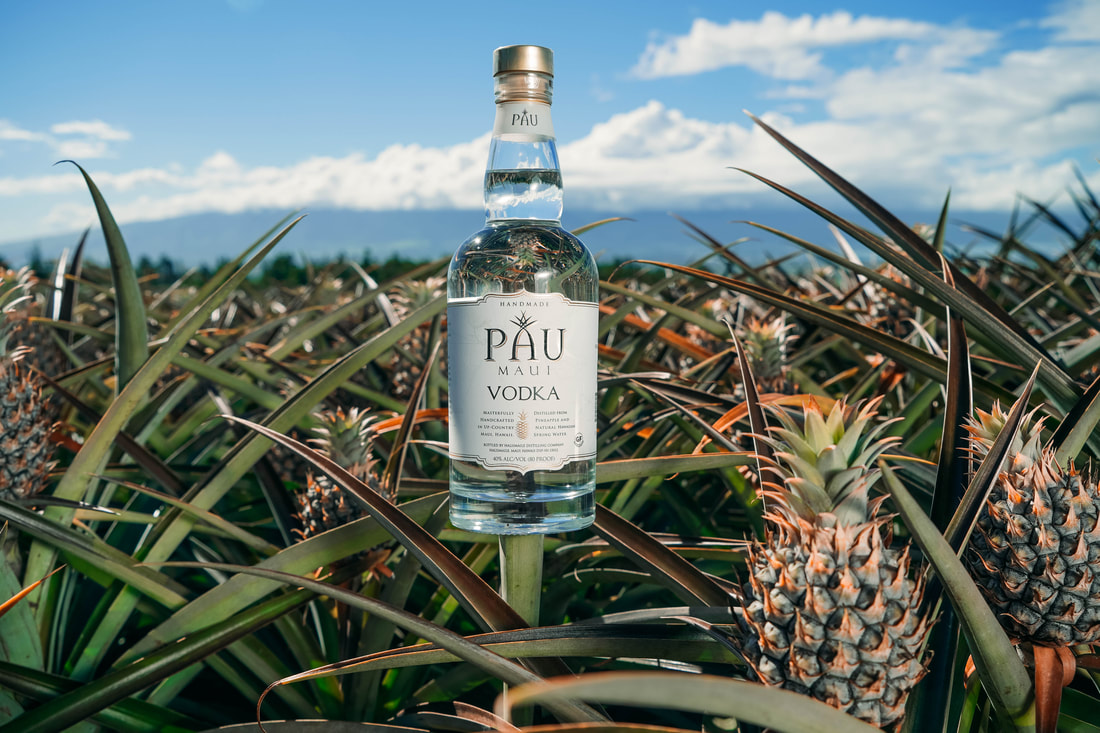
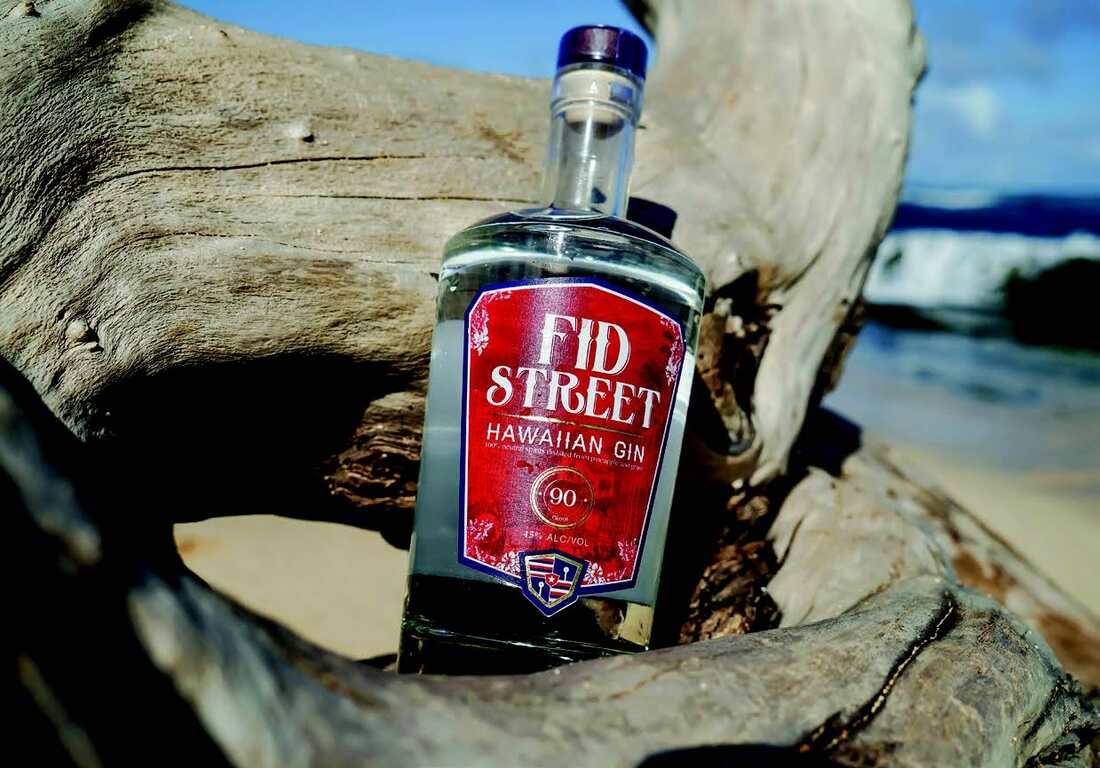
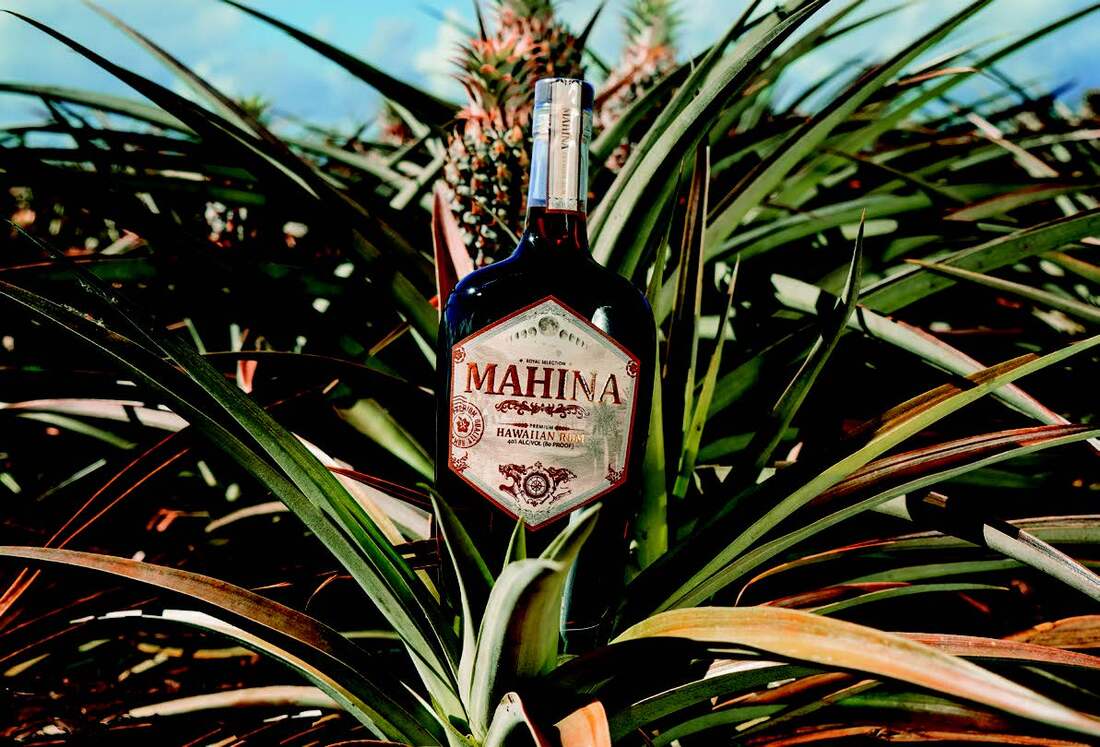
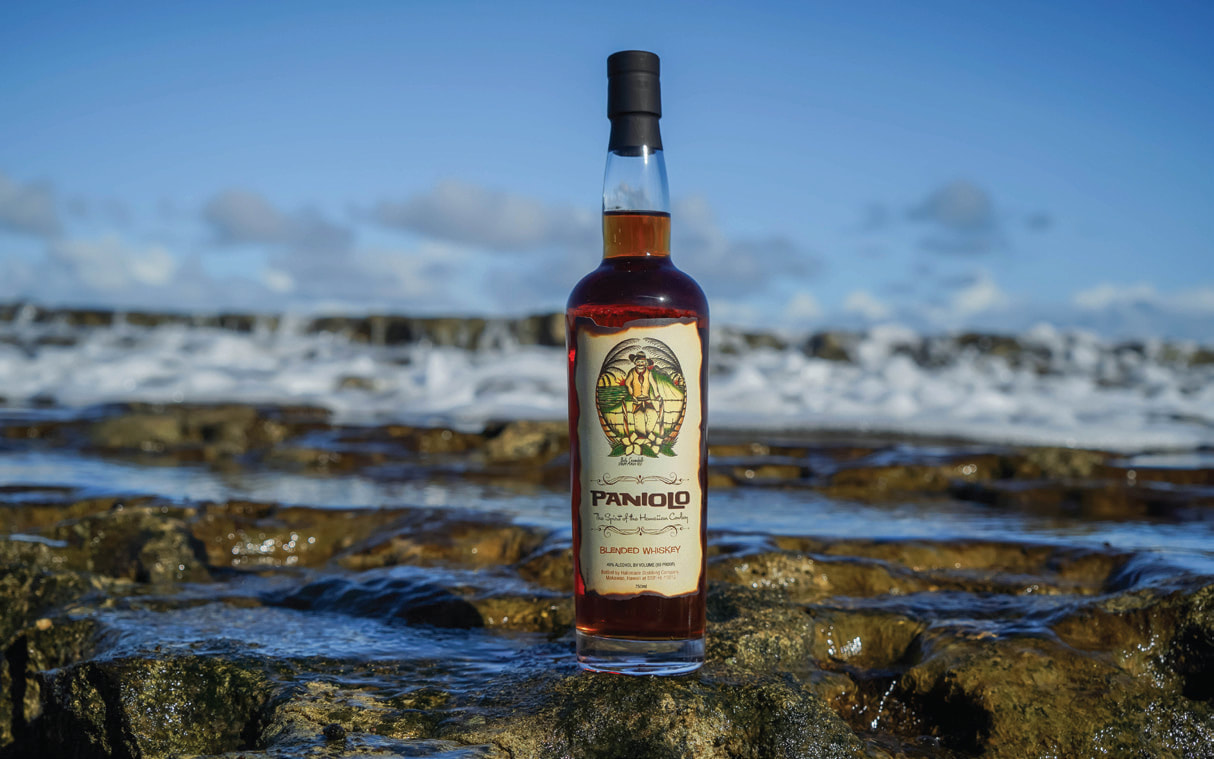
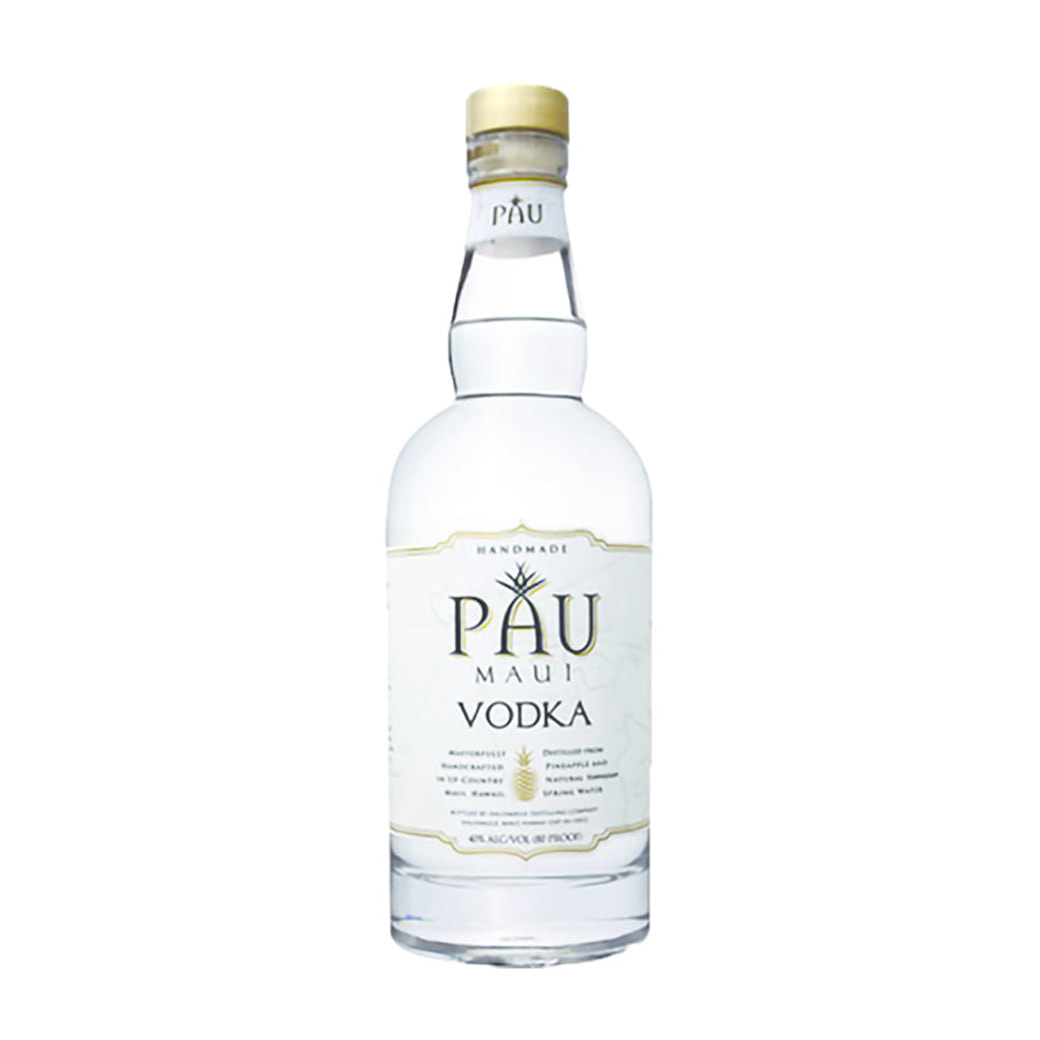
 RSS Feed
RSS Feed